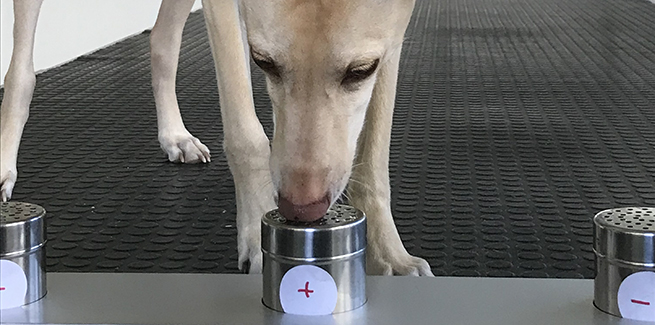You’ve got pee-mail—and it’s COVID test results

(Kössi , a Spanish galgo, sniffs for the coronavirus at the University of Helsinki. Photo courtesy of Anna Hielm-Björkman)
Kössi and Lucky knew the people had COVID-19 before the people did. More remarkably, they knew before the people even began to show symptoms.
The two dogs are old hands (or noses) at sniffing out sickness: They’ve previously been trained to detect breast cancer and prostate cancer based on scent profiles. Their newest challenge is sniffing out SARS-CoV-2, the virus that causes COVID-19 in people. They do require some additional daily maintenance, though. At the start of each day, the canine testers need to be “calibrated” with treats so they’ll know which puzzle they’re working on that session: cancer or coronavirus.
And that’s about the only downside to using dogs to sniff out COVID: with Kössi, and Lucky’s help, researchers at the University of Helsinki (UH) in Finland are on track to prove that dogs’ sense of smell could be a faster and more accurate test for coronavirus than the molecular-based tests currently available.
After collecting urine specimens from family members of patients across Finland who’d tested positive for COVID-19, lead researcher Anna Hielm-Björkman, PhD, associate professor of animal clinical research at UH, and her team trained the dogs to differentiate between positive and negative SARS-CoV-2 samples. Notably, it appears the dogs can also detect the presence of SARS-CoV-2 before patients display any signs of illness.
The researchers know this because the family members who gave urine specimens either hadn’t been tested, or had previously tested negative.
NEWStat reached out to Hielm-Björkman to find out more about the research, and how the dogs were able to detect the novel coronavirus in asymptomatic people. She said that when the dogs picked up on the presence of the virus in samples taken from people who had previously tested negative or hadn’t been tested at all, the researchers asked the donors to test again using the standard methods.
In every case, the donors tested positive.
But how far in advance of the retesting did the dogs know?
“We found that the dogs could see that a person was getting sick about four to five days before they got the disease,” Hielm-Björkman told NEWStat. “That was really encouraging because it means that the sensitivity of the dogs is better than the tests.”
Current testing for COVID-19 typically gives results in two to three days, but the dogs provide instant results. That’s part of the reason similar research is underway in half a dozen other countries, including France, Germany, Switzerland, Japan, and the United States. In fact, researchers at the University of Pennsylvania’s School of Veterinary Medicine are training dogs to detect COVID-19-positive saliva and urine, and expect to begin preliminary screening on human subjects as early as July.
Hielm-Björkman said everyone involved in this research sees amazing potential for employing dogs to help in the fight against COVID-19 and future pandemics by detecting coronavirus at border crossings and in concentrated living facilities like nursing homes.
Hielm-Björkman stressed that additional research is needed to confirm whether the dogs are specifically detecting the presence of SARS-CoV-2 instead of another virus, but said preliminary results are very promising.
Given that several dogs around the world have tested positive for COVID-19, presumably after having been infected by humans with the disease, how do the researchers protect Kössi and Lucky from possible infection?
Hielm-Björkman says protecting the dogs’ health is one of the main reasons they’re using urine samples: “We’ve done enough research to say that dogs can’t get [COVID-19] and their handlers can’t get [COVID-19] from exposure to urine.”
So how do the dogs do it?
Hielm-Björkman freely admits she has no idea. “We’re really not sure what they’re detecting at this point,” she said. Possibly they’re scenting something people with the virus are metabolizing in their urine, but that’s speculation. All she knows for sure is, it seems to be working so far—and better than any machine. “They’re not even comparable,” she said. “There’s no machine on Earth that can even come close.”
Hielm-Björkman and her colleagues jokingly refer to a dog’s ability to gather information by scenting urine, especially that of other dogs, to “reading their ‘pee-mails’: They know who’s in heat, what they had for breakfast, who has a new member in the family,” she said. “It’s kind of how we interpret our world through sight and sound—they interpret theirs through smell.”
But who would’ve thought we’d be the ones sending the pee-mails?



